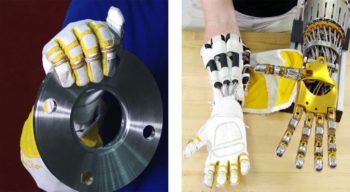Researchers at the NASA Johnson Space Center (JSC) in collaboration with General Motors (GM) have designed and developed Robo-Glove, a wearable human grasp assist device, to help reduce the grasping force needed by an individual to operate tools for an extended time or when performing tasks with repetitive motion. Robo-Glove has the potential to help workers, such as construction workers, hazardous material workers, or assembly line operators, whose job requires continuous grasping and releasing motions.
The Robo-Glove also has potential applications in prosthetic devices, rehabilitation aids, and people with impaired or limited arm and hand muscle strength. This NASA Technology is available for your company to license and develop into a commercial product. NASA does not manufacture products for commercial sale.
Benefits include:
- Wearable assist technology: a lightweight robotic glove that fits on your hand
- Small and compact design
- Human-safe robotics: pressure sensors give a sense of touch or haptic feedback
- Self-contained glove: actuators, pressure sensors, and synthetic tendons are embedded
- Ergonomic – the system helps reduce muscle strain from repetitive motion tasks
Applications include:
- Construction
- Hazardous material handling
- Medical
- Automotive Repair
- Manufacturing
- Repetitive motion work
- Oil and gas exploration
Originally developed by NASA and GM, the Robo-Glove technology was a spinoff of the Robonaut 2 (R2), the first humanoid robot in space. This wearable device allows the user to tightly grip tools and other items for longer periods of time without experiencing muscle discomfort or strain. An astronaut working in a pressurized suit outside the space station or an assembly operator in a factory might need to use 15 to 20 lbs of force to hold a tool during an operation. Use of the Robo-Glove, however, would potentially reduce the applied force to only five to 10 lbs.
The Robo-Glove is a self-contained unit, essentially a robot on your hand, with actuators embedded into the glove that provide grasping support to human fingers. The pressure sensors, similar to the sensors that give R2 its sense of touch, are incorporated into the fingertips of the glove to detect when the user is grasping an object. When that happens, the synthetic tendons automatically retract, pulling the fingers into a gripping position and holding them there until the sensor is released by releasing the object. The current prototype weighs around two pounds, including control electronics and a small display for programming and diagnostics. A lithium-ion battery is used to power the system and worn separately on the belt.
Watch the video here.
June 14, 2017





Reader Interactions